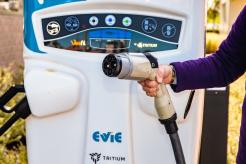According to the Department of Energy, 60,097 electric vehicle charging stations (EVCS) across the country cater to over 2 million EVs on the road. Recently, it was reported that 5% of the passenger vehicle sales in the country were electric vehicles. And if the 2030 predictions are anything to go by, the EVCS industry will remain a lucrative business as more automakers commit to a fully electric future.
Some big charging station companies that already run many stations include ChargePoint, Tesla, EVgo, and Greenlots. While this industry is still nascent, performance measurement is as crucial as every other business. These large companies invest heavily in real-time data analysis to measure the stations’ growth and optimal use.
For private investors looking to cut their niche in this growing market, the next big question is, how best can they manage their EV charging stations? What metrics should they focus on to maximize revenue, prioritize sustainability, save on energy, and avoid costly maintenance repairs?
Let’s delve into the details and find out the best metrics that can help to keep an EV charging network business thriving long into the future.
Charge Station Utilization

Image by Alphaartinan on Vecteezy
The charging station utilization rate is a key metric providing valuable information about the business. Whether it’s one or a network of stations, acquiring accurate data on when and how often drivers charge at a particular station informs the decision to expand the network or stay put.
A 20% utilization rate is often used as the baseline, and a rate above this may warrant network expansion. If customers are steadily increasing, an EVCS owner may need to install more electric vehicle charging infrastructure to cut short queue time and maintain steady utilization rates.
Measuring the utilization rate also gives them insight into the duration of the sessions. The data shows the time spent charging or plugged in and the peak charging hours and days.
A charging station owner can use the data to schedule reduced plugging time and maintenance to maximize uptime.
Revenue
Making good and steady profit margins is every investor’s end goal. The daily, weekly, or monthly revenue data helps EVCS owners to undertake accurate performance measurements for any period. Analyzing the revenue streams against revenue for one charge session or customer helps owners to seal any revenue leaks or increase opportunities for better revenue growth.
Uptime

Image by NCDOTcommunications on Openverse
Uptime is the availability of charging services in a calendar year. For instance, the difference in uptime percentages from 99% to 95% is a meager 4 points. However, such a slight difference may translate to about two weeks of downtime for an EV driver, which often causes charger anxiety.
This phenomenon is one of the main reasons why people hesitate to switch from their internal combustion engine (ICE) vehicle to an EV.
The Federal Highway Administration has set the target at 97% for each charging port annually, making it crucial for charging station owners to calculate their current uptime and work on increasing their capacity.
Taking action now will help them meet federal regulations, increase their dependability among their clients, and promote business sustainability.
Charging Equipment Maintenance

Image by Pakorn Sungkapukdee on Vecteezy
While EV charging equipment generally requires low maintenance, they need regular service for optimal performance. Incorporating an automated monitoring system may correct most of the issues on time.
However, scheduling physical equipment servicing is a proactive approach that reduces costs, downtime, and the frustration of constant charger breakdowns.
Remember that third-party maintenance contractors’ response time plays a part in determining the charging station’s uptime. The duration of the maintenance process, from investigation to final tune-ups, requires stringent measures to harness effective time management.
Software Management Systems
A centralized management software system is essential in effectively controlling charging stations. It brings together the utilization, availability, and revenue data aspects to a central point, allowing managers to analyze various performance metrics and promptly take appropriate measures.
Adopting the latest software is the right proactive step to gain maximum benefits from an EV charging business.
A few of the best EVCS management software to look out for are:
Earlier versions have only assisted drivers in locating the stations and processing payments. Now, they’ve incorporated other functions such as energy management, including the electricity consumed and the upgrades required to keep up the station’s uptime.
They also help the owners to provide a better customer experience through quick problem resolution and to make unbiased decisions based on real-time analytics.
Internet Connectivity
Internet connectivity plays a significant role in the efficient management of charging stations. With full-time internet connections, charging stations can appear in EV charging smartphone apps, help with customer authentication, and give them access to real-time information, including operational data, charging usage data, and urgent error reports.
Using smart technology to run unattended stations ensures that the customers are happy and the business gains a good reputation for top efficiency.
Key Takeaway
The electric vehicle industry will keep growing well into the future, calling for more investment in EV charging infrastructure. Private investors are key sector players looking to maximize their returns and minimize costs by closely monitoring key performance metrics.
The list above shows the main metrics a business owner needs to keep tabs on for effective charging station management and sustained profitability.
Although managers can incorporate EVCS remote-monitoring technologies, they cannot discount the importance of combining them with regular physical operation assessments for effective data collection. Whichever metrics the owners utilize will provide valuable data that can assist them in making informed decisions to safeguard the business and scale it to better profit margins.
Performance metrics ensure that the stations remain active throughout the year, maintain a stellar reputation online, and keep the revenue coming.
Featured Image by Zeger Stock on Vecteezy.






